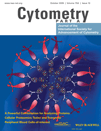Cytometric rulers with nanometer scaling
The measurement of molecular distances within cells is of central importance in many areas of biology and medicine. One of the most prominent fields of research is the interaction of the epidermal growth factor (EGF) family, particularly as the association of different members of this family is related to cancer development. A widely used technology for the determination of molecular distances is fluorescence resonance energy transfer (FRET). Leuchowius et al. (1) demonstrate the power of their recently developed assay of in situ proximity ligation analysis (2) for the determination of heteroassociation of members of the EGF family by flow cytometry. As also highlighted in a commentary (3), this method has several advantages, among which is the clear increase in assay sensitivity and simplification of the measurement. This technology may become a powerful tool for the analysis of clinical samples by quantitative microscopy tools.
The technological development of new green-to-orange emitting lasers (4, 5) and far red, infrared-sensitive detectors is going hand-in-hand with the chemical synthesis of new fluorescent dyes. Some of them rely on FRET for many valid reasons. They ensure increased sensitivity due to a (virtual) Stokes' shift whereby emission is further from the autofluorescence of the specimen. Furthermore, they bring in more colors, enabling increased complexity in the analysis of single cell phenotype and function.
Important future clinical application of high-content diagnosis by multicolor single-cell analysis where FRET dyes will be of particular relevance is Cellular Proteomics, as a prospective standard approach for diagnosis, therapy development, and predictive medicine. This is outlined in the consensus document of a European group of clinical chemists and biomedical researchers (6). This document extends the recently published consensus on proteomic analysis of liquid fluids (7) to cellular system analysis.
Clinical diagnosis demands, according to good laboratory practice requirements, a maximum level of standardization of the reagents. However, the stability of FRET tandem dyes is usually lower than that of its two components (donor and acceptor dyes). This instability may lead to a change in the color of the tandem dyes. Thus, they will emit more in the range of the donor than in that of the acceptor making cell detection and expression quantitation imprecise. This reduced stability is generally assigned to increased photodamage by reactive oxygen intermediates and may be reduced by protection from light exposure. Le Roy et al. (8) report an additional aspect that needs attention while using FRET dyes for immunophenotyping of living cells. The authors found that FRET degradation is actively done by living cells. FRET fluorescence did not shift when the cells' metabolism was blocked, but altered cell specificity in metabolically active cells. These observations need closer attention while using FRET-labeled reagents in a highly quality-controlled analytical environment.
Darzynkiewicz and coworkers did pioneering work on cytometry application in apoptosis assessment. Their recent work is among the highest cited of the journal (9, 10) and some of their publications are the standard work in the field (11). The group now focus on three molecules (12) which could be used as DNA damage indicators (10, 13-15): ataxia telangiectasia mutated (ATM) protein kinase becomes activated (A-ATM) in response to DNA damage, particularly when the damage involves the formation of DNA double-strand breaks (DSBs). Upon exposure of cells to ionizing radiation, activation of ATM was shown to correlate strongly with the number of DSBs. It is activated through Ser1981 autophosphorylation. Among the downstream targets, substrates phosphorylated by A-ATM are checkpoint protein Chk2 and H2AX histone. Phosphorylation of histone H2AX (P-H2AX) on Ser139 and Chk2 on Thr68 (A-Chk2) leads to their activation. The phospho-specific antibodies against these proteins allow assessing activation of these proteins and on this basis, quantifying DNA damage in individual cells. Multiparametric cytometry assays were used to correlate their phosphorylation with activation of caspase-3 (A-C3) and cell cycle progression, the events reporting induction of apoptosis or cell cycle arrest, respectively (16).
Multiparametric cytometry is important to simultaneously measure A-ATM, P-H2AX, A-Chk2, A-C3, and DNA content in studies of association between DNA damage, recruitment of DNA repair machinery, activation of cell cycle checkpoints, and induction of apoptosis. Actually, for the analysis of cigarette smoke-induced DNA damage in a similar system, one key protein in the apoptotic process, P53, was involved (12).
Glycosylation is an important post-translational modification (PTM) that is observed in the majority of all proteins. The site-specific nature of this modification plays a critical role in numerous cell recognition and signaling processes that regulate human development, immunity, and disease. Alterations from the normal biological processing of proteins, either genetically or epigenetically induced, may lead to severe health problems such as protein-losing enteropathy (17). A newly developed assay now enables highly sensitive PTM detection of proteins by flow cytometry (18). In the future, this method may be useful in clinical applications.
Acknowledgements
Dr. Jozsef Bocsi, Heart Center Leipzig, is acknowledged for his help with this editorial.




